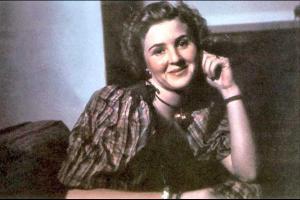Phyllis Edgerly Ring's Blog, page 12
December 6, 2016
How do we make room – for Life?
 Five years ago this week, as I followed the chapters of my novel — and the trail of Eva Braun’s life — to their conclusion, I faced a long day of train travel. It would take me from the southern edge of Germany’s border with Austria nearly to the top of Germany.
Five years ago this week, as I followed the chapters of my novel — and the trail of Eva Braun’s life — to their conclusion, I faced a long day of train travel. It would take me from the southern edge of Germany’s border with Austria nearly to the top of Germany.

Photo: David Campbell
The night before – the entire day before – I’d been riddled with anxiety. I had four train connections to make, and my mind was unhelpfully cataloging every single thing that could possibly go wrong.
This kind of turmoil eventually arises every time I travel alone for extended periods of time, and always for the same reason. After the dreamy honeymoon of my first few days, just the fact that I’m on my own in a place that’s out of my element triggers an inner myth that’s as unkind as it is false: I need to find some way to be in control, in order to be safe.
Since, deep down at the heart of truth, I recognize that I’m never going to be able to do that, this leads inevitably to a separated sense of aloneness that feels eternity-sized. I also know it’s an experience that’s universal, not one of us escapes it. Surely, this is what any addictive tendency seeks to squelch and suppress – anything but have to face it.
Reading a wonderful manuscript from a writer friend reminded me of the power question I’ll have ready next time this happens: “Is control something I ultimately even WANT?”
The night before that trip, I finally stumbled on some steadying words from Eckhart Tolle:
“Your life situation may be full of problems — most life situations are — but find out if you have any problem at this moment. Not tomorrow or in ten minutes, but now. Do you have a problem now?
“When you are full of problems, there is no room for anything new to enter, no room for a solution. So whenever you can, make some room, create some space, so that you find the life underneath your life situation.”

In that cozy Bavarian hotel room, I hadn’t a problem worth noting, other than my monkey mind. It was the eve of a holiday in Germany called St. Niklaus Tag, Dec. 6, and every aspect of the setting in which I found myself was idyllic, supportive, friendly and inviting. Yet I was depriving myself of the experience with every anxious moment.
So, relaxing into Tolle’s invitation, I remembered the spirit of this holiday, one of the first I experienced in my childhood, filled with warm, lovely memories.
Suddenly the thought popped up, as brightly and boldly as a child’s would: “I wonder whether, if I put my boots outside the door, they’ll be filled for St. Niklaus Tag?” It seemed silly, and it made me happy, and for the rest of the night, I enjoyed my hours and had a restful sleep.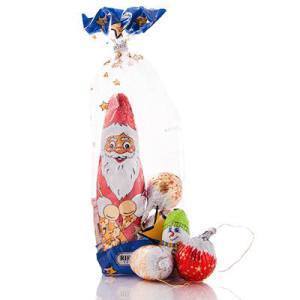
The next morning, when I opened the door of my hotel room to wheel my luggage out and head for that first train, there in the middle of the floor outside was a red gift bag festooned with stars. Inside were a variety of seasonal treats, including a tall chocolate “Christmas Man”, an orange, apple, tiny ginger star cookies with icing, and 2 each in the shell of walnuts, almonds, and hazelnuts.
Exactly the contents that might fill a child’s shoes on St. Niklaus Tag.
I was so stunned, I wondered whether I’d only dreamed waking up and bundling myself out that door.
Surely they did this for all the guests? (There was a conference-worth of them staying.) But the bag outside my door was the only one I saw waiting in that hallway.
 When I asked the woman at the desk about it as she checked me out, Bavarian-friendly but completely non-committal, she told me, “Oh, aren’t there always all kinds of nice surprises that can happen in a day? Have a good trip.”
When I asked the woman at the desk about it as she checked me out, Bavarian-friendly but completely non-committal, she told me, “Oh, aren’t there always all kinds of nice surprises that can happen in a day? Have a good trip.”
As I munched my treats from south-to-north, I had so much fun watching the scenery, visiting with fellow travelers, and enjoying the journey, I forgot to worry about anything at all.
“ …make some room, create some space, so that you find the life underneath your life situation.” So that you can LIVE it.
Find more about The Munich Girl here:

http://www.amazon.com/Munich-Girl-Novel-Legacies-Outlast/dp/0996546987/

November 30, 2016
The Munich Girl: the secrets we keep
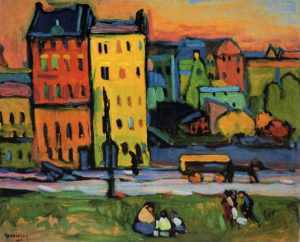
Wassily Kandinsky, “Houses in Munich,” 1908
Reviewer and author Barb Taub has done The Munich Girl a big service with her insightful review:
“With her book, The Munich Girl, author Phyllis Edgerly Ring points out that an entire nation can’t be understood or explained with one label.
‘She does this by examining the life of one almost-invisible woman: Eva Braun, the “Munich Girl’ who was Hitler’s mistress from the time the seventeen-year-old girl met the man over twenty years her senior until their wedding followed a day later by her suicide at his side when she was 33. 
“Although The Munich Girl has the feel of a memoir, it is a historical fiction that tells the story of three women. We first meet Anna, an American woman married to history professor Lowell. Anna has grown up in a house full of secrets, one of which is her father Rod’s war-spoils portrait that has hung in their dining room all her life. The second is her mother, Peggy, who has died just before the story begins. And of course, the third is Eva, and her doomed relationship with Adolf Hitler. As Anna is clearing out Peggy’s house, she comes across a manuscript that tells both Peggy’s story and that of her unlikely friend, Eva.
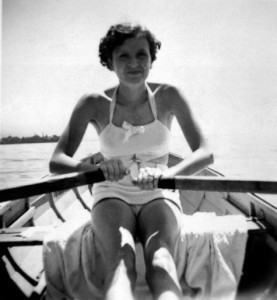 “Anna’s story is told in alternating points of view. First we have her own experience as a child born in Germany at the end of the war, but raised in the United States. Having grown up feeling like an outsider and desperate to belong, she subverts her entire life into supporting her husband Lowell’s career and goals. When he orders her to work at an inherited family magazine that he thinks will help his career, she is at first reluctant but then captivated by her assignments, including Eva Braun’s story. But most of all she’s drawn to the magazine’s German-American editor, Hannes. But when Anna finds that her mother knew Eva Braun, and when she starts to suspect that Peggy’s secrets go beyond the portrait signed with Adolf Hitler’s initials, Anna’s interest becomes an obsession.
“Anna’s story is told in alternating points of view. First we have her own experience as a child born in Germany at the end of the war, but raised in the United States. Having grown up feeling like an outsider and desperate to belong, she subverts her entire life into supporting her husband Lowell’s career and goals. When he orders her to work at an inherited family magazine that he thinks will help his career, she is at first reluctant but then captivated by her assignments, including Eva Braun’s story. But most of all she’s drawn to the magazine’s German-American editor, Hannes. But when Anna finds that her mother knew Eva Braun, and when she starts to suspect that Peggy’s secrets go beyond the portrait signed with Adolf Hitler’s initials, Anna’s interest becomes an obsession.
“This is an amazing story full of layers and meaning. The settings are beautifully detailed and seem both timeless and perfectly anchored in their little bubbles of time. But within those stories, author Phyllis Edgerly Ring has created three fully-realized women who are very different, but who manage to have so many themes in common. 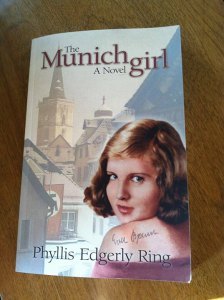
“One theme is the deals women make with themselves to allow others to achieve happiness or satisfaction, often by denying themselves those very things.
“Another theme is the secrets we keep from others and from ourselves. The one question that history demands of Germany—how could you follow a monster like Hitler?—is brought down to the personal level. Why would Eva remain with Hitler?”
Find the rest of Barb’s review at Goodreads: https://www.goodreads.com/review/show?id=1499833670


November 26, 2016
Setting a course for Soul-sized expression
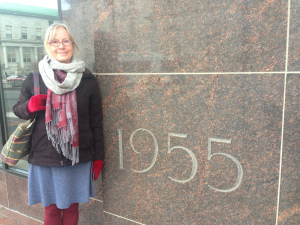 As I celebrate another year in The Munich Girl’s life, and my own, I’m pondering the power of expression in the world, the double-edged qualities of speech, the timeless gifts of questions and listening, and the potential of art to convey the wholeness of our experience.
As I celebrate another year in The Munich Girl’s life, and my own, I’m pondering the power of expression in the world, the double-edged qualities of speech, the timeless gifts of questions and listening, and the potential of art to convey the wholeness of our experience.
I’m revisiting the path along which the novel led me, hoping to mine some reflective memoir. As I do, I’m inspired by words like the following ones from writers with soul-sized perspectives.
“Writing about one’s own or another’s life poses serious challenges. A writer trying to represent his life in a book engages himself in ongoing negotiations about what information to include and what to withhold, what he believes is true and what he wants readers to think is true,” says Helena Hjalmarsson. 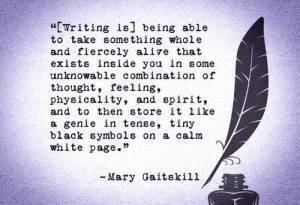
“The need for synthesis – coherence, connections between past and present – is a constant struggle … ” Hjalmarsson notes. “Often, the sense of life as a logical, purposeful unfolding becomes more important to the autobiographer than objective truth. Also vital to writers of autobiographies is the drive to make their work relevant and accessible to their readership – as well as a desire for connection, a social and spiritual need to ‘reincarnate,’ to have their hard-won perspective exist outside themselves.”
Jhumpa Lahiri writes, “It was not in my nature to be an assertive person. I was used to looking to others for guidance, for influence, sometimes for the most basic cues of life.

Painting: Judy Wright
“And yet writing stories is one of the most assertive things a person can do. Fiction is an act of willfulness, a deliberate effort to reconceive, to rearrange, to reconstitute nothing short of reality itself. Even among the most reluctant and doubtful of writers, this willfulness must emerge. Being a writer means taking the leap from listening to saying, ‘Listen to me.’ ” Lahiri cuts right to the core, in this.
Elizabeth Sims recently shared timely words about this process in a blog post called “A Real Writer’s Duty”:
“These days when extraordinary, historic events occur, everybody becomes a writer. Social media enables all of us to spew impassioned opinions—joy, outrage, elation, despair—if we want to. And so many do. And free speech is great. 
“But a real writer of either fiction or nonfiction takes a much longer and deeper view of human affairs and human nature than most people.” (How I love this. Indeed, I live for it.)
“A real writer is more curious than defensive,” she continues. “A real writer explores. A real writer is ready to be surprised. A real writer never panics. A real writer knows the world is in the work.”
Find Elizabeth’s Zestful Writing Blog here:
http://esimsauthor.blogspot.com/2016/11/a-real-writers-duty.html


November 20, 2016
What shall we keep room for in our hearts?
“Evolution is transformation. And transformation is happening all the time. It happens as we learn new things … ” notes author Christine DeLorey.
“Evolution is not an automatic ever-ascending spiritual conveyor-belt,” she adds, “but the result of our ability to face reality, adjust, adapt, and change.” 
A key element of our transformative path is contrast, whose intensity and extremes can sometimes seem — and feel — shocking. Even disheartening.
How can we maximize its effectiveness, by seeing what it is pointing to, for our heart’s understanding? What is it helping us remember? And how is it reminding us of all that we do not yet know?
“Keep some room in your heart for the unimaginable,” urges poet Mary Oliver, and theologian Paul Tillich reminds, “The first duty of love is to listen.”
“ … if you are willing to let your heart break completely open, with no internal narrative controlling the opening, you will discover the pure, innocent love that is alive in the core of every emotion, every feeling, everybody,” writes Gangaji.
“It remains pure and spacious regardless of change or loss.”
 Once this happens, then perhaps we are equipped at last for what these words of ‘Abdu’l-Baha’s invite:
Once this happens, then perhaps we are equipped at last for what these words of ‘Abdu’l-Baha’s invite:
“Make ready thy soul that thou mayest be like the light which shineth forth from the loftiest heights on the coast, by means of which guidance may be given to the timid ships amid the darkness of fog …”
Including those often-timid ships of our own small selves.


November 15, 2016
Our most liberating destination: beyond expectations
My thanks to blogger Rachel Poli, who is sharing a Guest Post of mine at her book-review site: 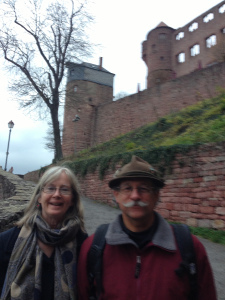
A year ago this week, I was in Germany when my novel, The Munich Girl, published last November.
In the eight years I’d spent following this story’s trail, I never once imagined that life would bring me back there for such a personally significant landmark.
This book’s pathway has been filled with things I’d never have expected.
When I was a military brat in Europe in the 1960s, my first friends were German families. After I married another brat who’d also spent part of his childhood in Germany, we began returning there as often as we could. I realized that if I wanted to understand this culture I love so much, I needed to understand more about Germany’s experience during the war.
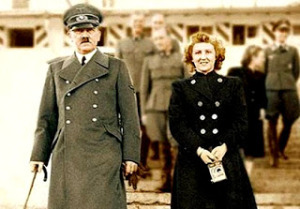 Never could I have imagined how quickly that intention would take me straight to Hitler’s living room. Within days, I received a copy of British writer Angela Lambert’s biography of Eva Braun.
Never could I have imagined how quickly that intention would take me straight to Hitler’s living room. Within days, I received a copy of British writer Angela Lambert’s biography of Eva Braun.
Then a combination of entirely unexpected circumstances led to my finding the portrait of Braun that began unwinding the sequence of events in The Munich Girl. 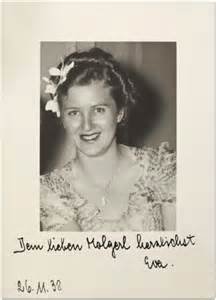
A major turning point in the story’s development occurred when I discovered, while researching the war crimes Trials at Nuremberg, that an action of Eva Braun’s in the last week of her life saved the lives of about 35,000 Allied prisoners of war.
Two members of my mother’s family were among them.
Link to the post at Rachel’s blog here:
https://rachelpoli.com/2016/11/15/creative-process-invites-us-beyond-our-expectations/
SALE: The price of the novel’s Kindle version is dropped to $1.99 this week as part of the book’s anniversary celebration.
You can find more about The Munich Girl: A Novel of the Legacies That Outlast War at:
http://www.amazon.com/Munich-Girl-Novel-Legacies-Outlast/dp/0996546987/
Purchase links: Amazon US | Amazon Ca | Amazon UK


November 11, 2016
Born of certitude, inhabiting our lives fully

Photo: Liz Turner
GLEANINGS FOUND HERE AND THERE:
The inner joy that every individual seeks, unlike a passing emotion, is not contingent on outside influences; it is a condition, born of certitude and conscious knowledge, fostered by a pure heart, which is able to distinguish between that which has permanence and that which is superficial.
~ The Universal House of Justice
The beauty of the terrible situation that we are in is that it forces us back into ourselves to fully inhabit our own lives.

Photo: Nelson Ashberger
~ Jim Haba
Acceptance of what is – and the way it makes you feel – is the mother of invention.
Balance does not mean uniformity. It means arranging things in way that enables energy to move FREELY.
Creative energy is magnetic emotional energy. It attracts. It draws us to it – and draws itself out of us.
~ Christine DeLorey


November 3, 2016
A year with The Munich Girl
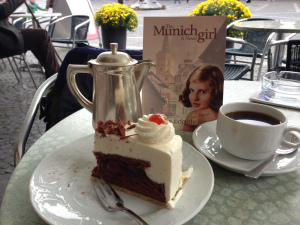
Come celebrate with me: One-year Birthday Party for The Munich Girl: Monday, Nov. 14, 6-8, Shooter’s Pub, Exeter, NH
A highlight for me one year ago, as my novel, The Munich Girl, came into the world, was my return to the first place in Germany where my family lived when I was a child,
On the cloudy November afternoon that the book published, I faced the Main River in the tiny village of Dorfprozelten and offered my thanks at the grave of Herr and Frau Geis, who shared their house with my family back in the early 1960s.
It was because my military family lived “on the economy” with them that my sense of myself as a citizen of the world began so early.
The fact that my family established close ties with German people in post-war Europe also inevitably led me to want to understand the experience of Germans themselves during the war.

With my British Grandmother outside the plant-filled window of the room in which I slept in the Geis family home in Dorfprozelten, Germany.
I’d never have imagined this path would take me through Hitler’s living room as it drew me into the life of his longtime mistress, later wife, Eva Braun.
“How will you ever get readers past the fact that it’s her – that she’s such a large part of the story?” is a question I grew used to hearing.
I wouldn’t. I knew that from the start. Readers would embark on that particular journey only if they were willing to.
This story in no way seeks to exonerate or “redeem” her.
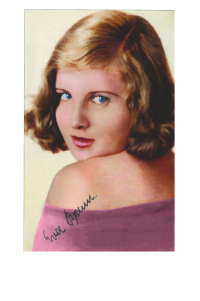 Rather, she makes a good motif for looking at the ways in which many people, women in particular, suppress our own lives – or often don’t even claim those lives fully at all.
Rather, she makes a good motif for looking at the ways in which many people, women in particular, suppress our own lives – or often don’t even claim those lives fully at all.
The story of The Munich Girl is about many things, including, of course, Hitler’s mistress, Eva Braun, and many facets of history from the time of the war in Germany.
It is also about the power of friendship, and the importance of our often ignored and overlooked inner life, without which our world careens increasingly out-of-balance, as it did in those wartime days.
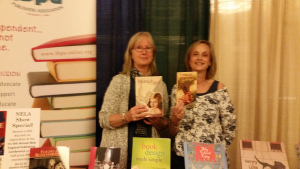
With author Lenna Kutner at the New England Library Association conference last month.
Much like the book’s protagonist, Anna, I repeatedly experience what invites me to look beyond what I think I know, and have understood about life. The process of uncovering the story has helped me remember many kinds of homecomings, spiritual and material, that life brings to us.

Childhood photo / Eva Braun (middle) with father, Fritz, and sister, Ilse.
At its heart, it’s a story about outlasting that chaos and confusion that unavoidably visit us, in both public and private wars, and how we transcend those challenges. We seem to do that by valuing, and believing in, the stronger possibility in all of the good that we are willing to contribute to building together.
Part of our ability to do that, I’ve come to believe, rests in being able to recognize that human beings aren’t usually all good, or all bad, but a complex mix of where our experience, understanding, and choices have led us.
As one character in The Munich Girl observes: “Sometimes, we must outlast even what seems worse than we have imagined, because we believe in the things that are good. So that there can be good things again.”
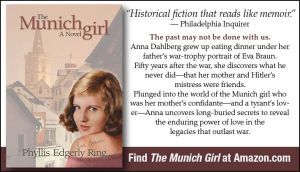 Eight years ago when the process of this book began, I also couldn’t have imagined what those words might come to mean in the atmosphere of our world today. I thank every reader who’s giving the book time, and also offering thoughtful reflection that helps me to continue learning from the pathway of this story, every day.
Eight years ago when the process of this book began, I also couldn’t have imagined what those words might come to mean in the atmosphere of our world today. I thank every reader who’s giving the book time, and also offering thoughtful reflection that helps me to continue learning from the pathway of this story, every day.
Find more about The Munich Girl here:
https://www.amazon.com/Munich-Girl-Novel-Legacies-Outlast/dp/0996546987


October 31, 2016
What is Spirit calling for?
As I’m preparing for some upcoming author visits, I’ve been reflecting on themes that are surfacing in these wildly turbulent times.
The planet, and the unfailing presence of Spirit in the world are speaking.
What are they calling for? How are we listening, or not? How are our hearts — Spirit’s intended home, by Divine design — responding, or not?
“All that is in heaven and earth I have ordained for thee, except the human heart, which I have made the habitation of My beauty and glory;” Bahá’u’lláh wrote nearly a century and a half ago, “yet thou didst give My home and dwelling to another than Me; and whenever the manifestation of My holiness sought His own abode, a stranger found He there, and, homeless, hastened unto the sanctuary of the Beloved. Notwithstanding I have concealed thy secret and desired not thy shame.”
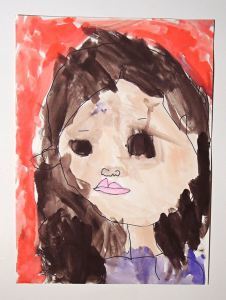 The indigenous, Native peoples in every part of the planet know, and honor, the truth carried in these words. They know, too, that in so many cultures, as in their own, water represents spirit, the very source of all life.
The indigenous, Native peoples in every part of the planet know, and honor, the truth carried in these words. They know, too, that in so many cultures, as in their own, water represents spirit, the very source of all life.
And today, they are speaking from the “heartland” of my country.
“The eyes of the future are looking back at us and they are praying for us to see beyond our own time,” author Terry Tempest Williams has written. “To protect what is wild is to protect what is gentle. … Wilderness lives by this same grace. Wild mercy is in our hands.” 
Over the next two days, Baha’is around the world will focus our hearts on love, unity, and the oneness in which the Creator has fashioned humanity as we gather to celebrate Twin Holy Days, the Births of the Báb, and of Bahá’u’lláh.
“The tabernacle of unity hath been raised; regard ye not one another as strangers. Ye are the fruits of one tree, and the leaves of one branch.”
Bahá’u’lláh
My thanks to Patricia Hupahu Locke (Patty), age 5, named for her brave-hearted Grandmother,
for the beautiful artwork here. Her family’s hearts are standing with those who, at Standing Rock, are standing for the truth of Spirit for all humanity. And my heart stands with them.


October 23, 2016
Synchronicity’s “results” are always best
 A recent experience with a review of The Munich Girl reminded me, once again, of the beautiful synchronicity with which Life works — perhaps in spite of our “best planning” — and the delicious surprises that result. It was another sweet affirmation that the desires of our hearts aren’t lost, though the way in which they come into reality is often far beyond what we imagine.
A recent experience with a review of The Munich Girl reminded me, once again, of the beautiful synchronicity with which Life works — perhaps in spite of our “best planning” — and the delicious surprises that result. It was another sweet affirmation that the desires of our hearts aren’t lost, though the way in which they come into reality is often far beyond what we imagine.
When the novel’s print version came out almost a year ago, I dearly hoped that the book might receive coverage at the Story Circle Book Reviews network, a very thoughtful place where readers connect.
I was grateful when they agreed to receive a copy for potential review, since the world of books has become, now, a seemingly infinite universe of them. 
I was advised that the book might or might not be requested. And, indeed, the available copy sat there, unrequested, over these many long months.
Then last week, reader (and fine writer) Margaret Dubay Mikus delivered the lovely surprise: she had read the book, shows real understanding of both the story and its themes, had been kind enough to write a wonderful review — and Story Circle Network had accepted and published it!
Margaret writes:
“The [Munich Girl] also looks at the role of women in different cultures and periods in a way that is quite relevant right now.
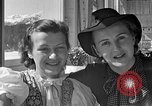
“Do women choose to play the lead in their own lives or do they sacrifice themselves for others?
“Ring also leads us to ask what we know of our parents’ lives. How might their experiences or traumas be passed down to us? How open are we to the changes that can come from deep healing? 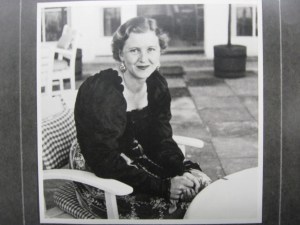
“You will want to cheer for Anna as she is drawn into the discovery of her past, re-creating her present, releasing her to soar into a future of possibilities. Engrossing and engaging with surprises and plot twists. I wanted to keep reading to find out what happens next.”
Find Margaret’s full review at: http://www.storycirclebookreviews.org/reviews/munichgirl.shtml


October 18, 2016
Thoughts from A Bookish Affair
My thanks to blogger Meg Wessell for making time for my novel, The Munich Girl, recently and sharing her thoughts about it.
“The Story – summary from Goodreads.com:
‘Anna Dahlberg grew up eating dinner under her father’s war-trophy portrait of Eva Braun. Fifty years after the war, she discovers what he never did—that her mother and Hitler’s mistress were friends. The secret surfaces with a mysterious monogrammed handkerchief, and a man, Hannes Ritter, whose Third Reich family history is entwined with Anna’s. 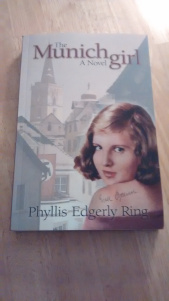
“Plunged into the world of the “ordinary” Munich girl who was her mother’s confidante—and a tyrant’s lover—Anna finds her every belief about right and wrong challenged. With Hannes’s help, she retraces the path of two women who met as teenagers, shared a friendship that spanned the years that Eva Braun was Hitler’s mistress, yet never knew that the men they loved had opposing ambitions. … ‘ 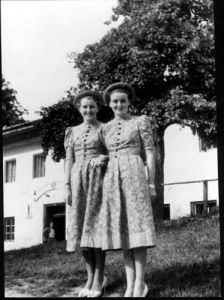
“My Two Cents: Eva Braun is infamous. Even as a history lover, I did not know much about her at all besides the fact that she was Hitler’s mistress.
“This book sheds light on the fact that at one point, she was just another German schoolgirl as Peggy, Anna’s mother is in this book.
“The juxtaposition between who she was and who she became was absolutely fascinating. It is easy to see how the author was drawn to telling this story.”
Find Meg’s review post at her blog, A Bookish Affair:
http://abookishaffair.blogspot.com/2016/10/review-munich-girl-by-phyllis-edgerly.html






